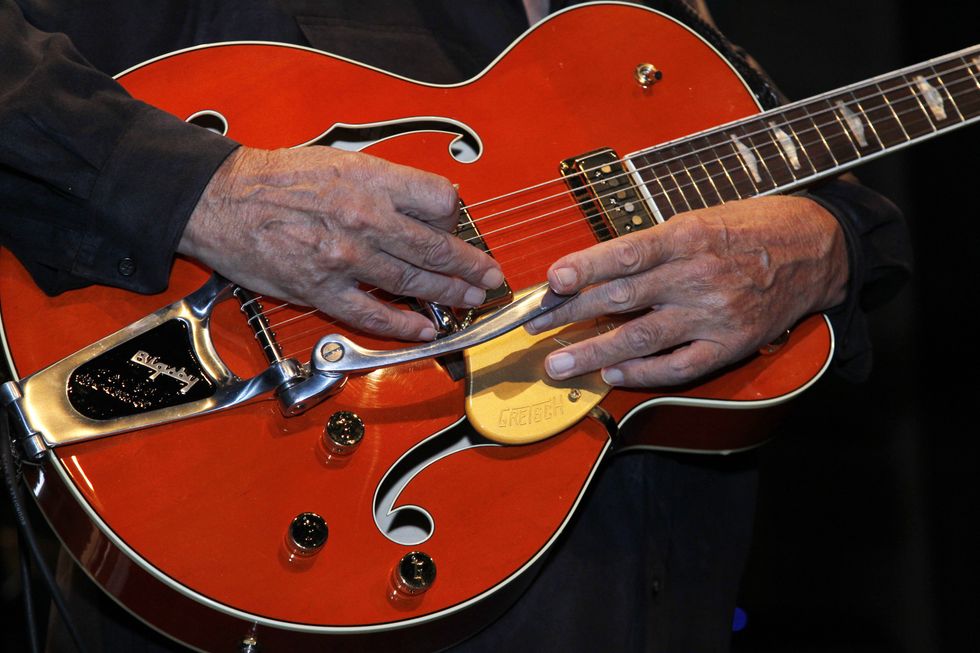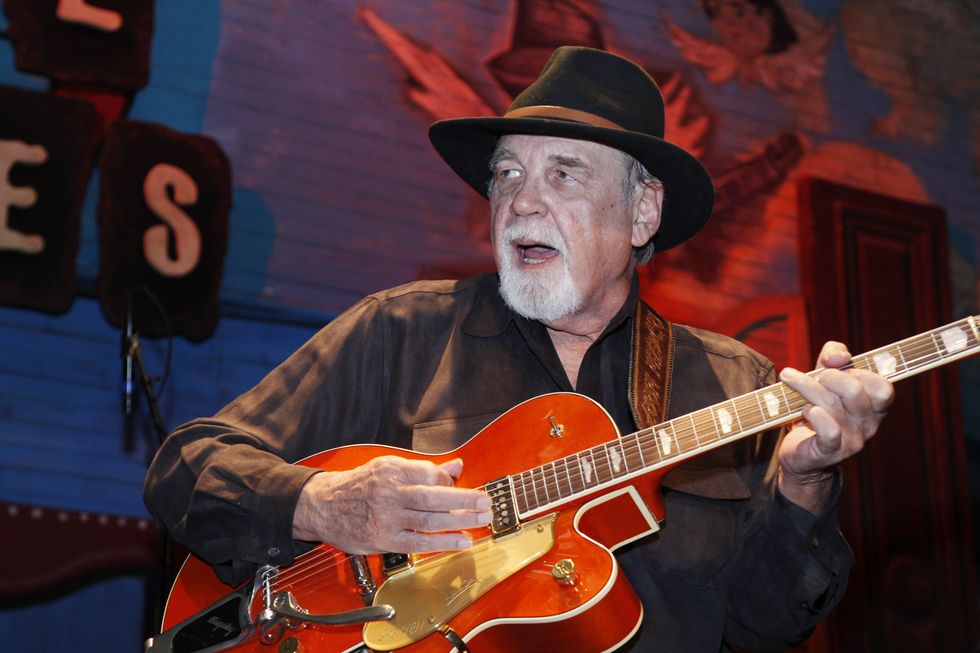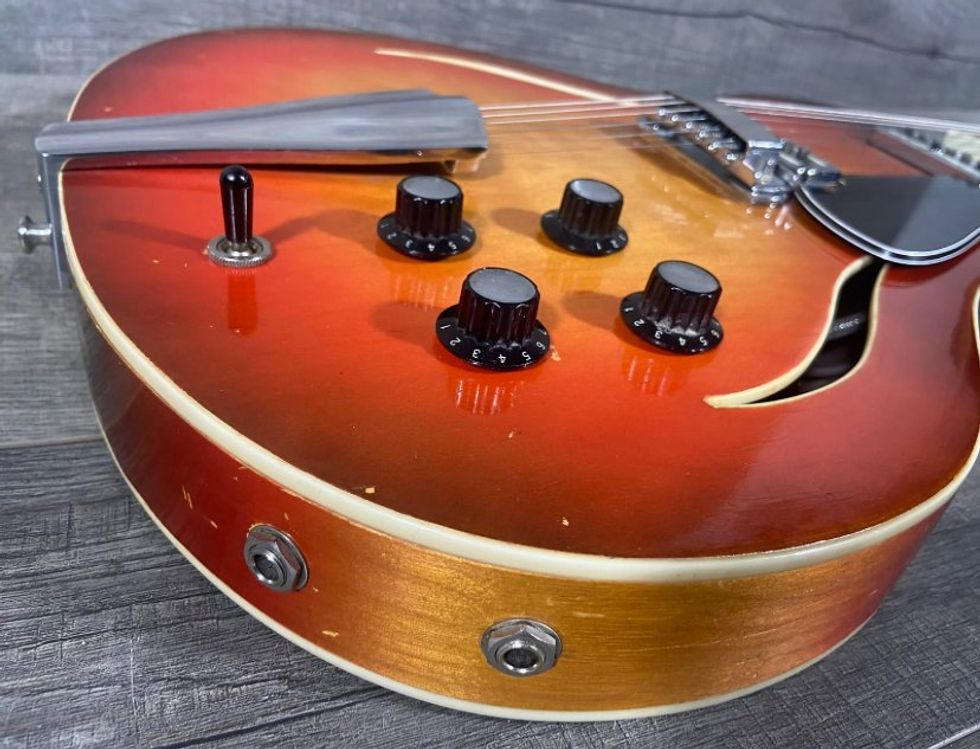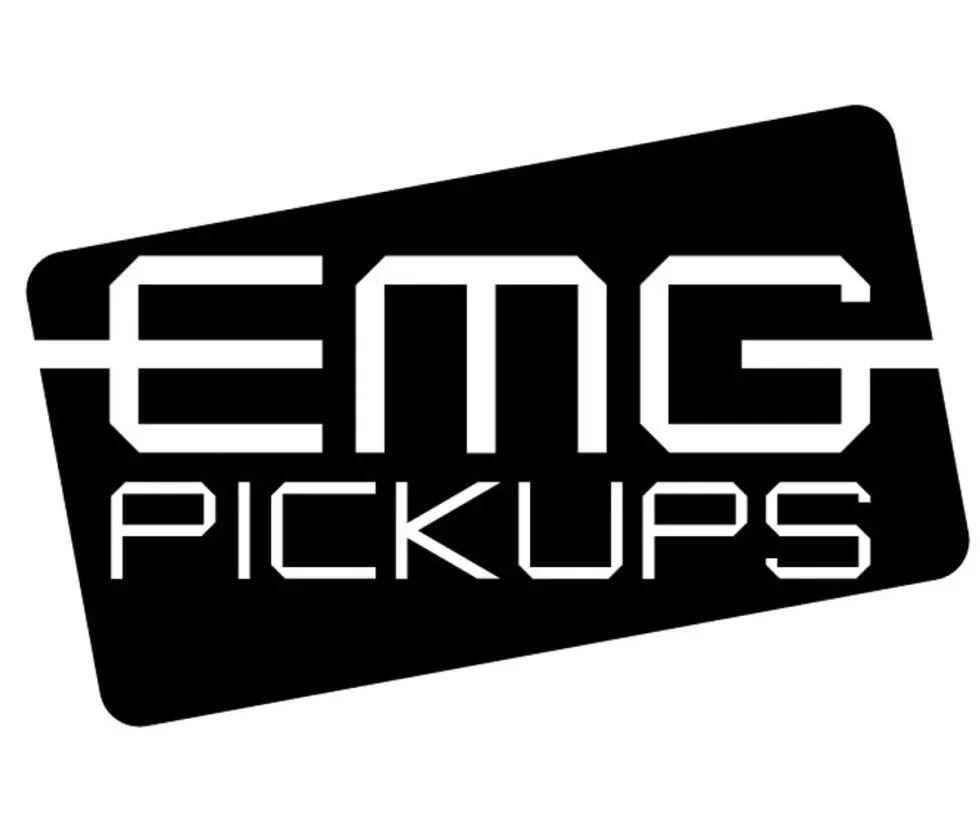
A youthful Duane Eddy poses with one of his Gretsch 6120s in this early career promotional photo.
The Gretsch 6120-bearing instrumental-rock pioneer has died at age 86, leaving behind an unmistakable sonic thumbprint and that continues to reverberate in creative music.
Instrumental rock arrived with a growl and a twang in 1958. The growl was from Link Wray’s fierce “Rumble,” which put distorted guitar on the pop charts—at No. 16—for the first time. The twang was the low, reverb-bathed, tremolo-burnished sound of Duane Eddy’s Gretsch 6120 on “Rebel Rouser,” which reached No. 6 on Billboard’s Hot 100 in May.
For the next 66 years, Eddy and his 6120 were inseparable, and he remained the undisputed “King of Twang,” releasing 21 albums over the next nine years that influenced the sound of guitar, from the Shadows and the Beatles to John Fogerty and Bruce Springsteen to the composer Ennio Morricone, whose famed spaghetti Western soundtracks often employed a 6-string approach—big tones, big melody—plucked from the Eddy handbook.
The master of twang died on Tuesday, April 30, of complications from cancer at a hospital near his home in Franklin, Tennessee. He was 86 years old and is survived by his wife, Deed, and daughter, Jenni Eddy. At his passing, there was an outpouring of tributes from members of the guitar community. Springsteen posted a video remembering Eddy on Instagram, noting “without Duane, there’s no this,” before playing the riff from “Born to Run” on a Gretsch hollowbody. And Fogerty called Eddy “the first rock ’n’ roll guitar god.”
Eddy was born in Corning, New York, on April 26, 1938, and was playing guitar by age 5. After his family moved to Coolidge, Arizona, he formed his first band with high school friend Jimmy Delbridge, called Jimmy and Duane. They were discovered by local disc jockey Lee Hazelwood, who would become a famed singer-songwriter and producer. Hazelwood produced Eddy’s first single, 1955’s “I Want Some Lovin’,” and continued to work with Eddy into 1960.

Eddy wanted a Gretsch, in part, because of its Bigsby whammy bar. As he suspected, the device became an important part of his twangy sound.
Photo by Joseph A. Rosen
By ’55, 16-year-old Eddy had already begun to formulate his own style, picking out melodies on his guitar’s bass strings. Soon he would acquire his first 6120. Eddy used the instrument’s Bigsby vibrato and his low tone, saturated with reverb and tremolo, and picked the strings about four inches above the bridge to complete his distinctive sonic profile. Another element was his choice of 2x12 Magnatone amps, which he had hot-rodded to 1x15s with the output power goosed up from 65 to 100 watts. As legend has it, Eddy became so devoted to reverb that he once acquired a 2,000-gallon water tank to use as an echo chamber and placed an amp inside it during a recording session.
In 2018, when journalist Michael Ross profiled Eddy for Premier Guitar, Eddy told Ross the story of how he acquired the first of his beloved Gretsch models: “After we moved to Arizona, I bought a goldtop Les Paul for $75 in a hardware store in a little town south of Phoenix in about 1954. A guy in town made these orange-crate amps with a 12" speaker and chicken wire in the front. I used that for the first couple of years. Then, around 1957, I was at Ziggie’s Music in Phoenix looking at guitars. I looked at a White Falcon, but it was too expensive and didn’t play that great. They brought out an orange 6120 and handed it to me. It sat in there just so beautifully and the neck was a dream. I thought I would come back with my father to cosign for me. I picked up my Gibson and started out. Ziggie [Zardis] said, ‘Where you going?’ I replied, ‘I’ve got to get some dinner and go to work.’ ‘Don’t you want to take this with ya?’ he said. I said, ‘We haven’t signed anything.’ He told me, ‘It’s your guitar, take it. When your dad gets back, have him come by and sign the paperwork.’ I left there a happy camper. My dad didn’t get there for about three months.” [laughs]
“A guy in town made these orange-crate amps with a 12" speaker and chicken wire in the front. I used that for the first couple of years.”
Between 1958 and 1962, Eddy and his 6120 sound became embedded in American popular culture. On radio, “Rebel Rouser,” “Ramrod,” “Cannonball,” “Forty Miles of Bad Road,” and “Because They’re Young” became staples. And on TV, he contributed the theme to the hit show Have Gun — Will Travel (the song is 1957’s “The Ballad of Paladin,” with vocalist Johnny Western), then covered the instrumental title number Henry Mancini composed for the detective series Peter Gunn, which reached No. 27 on the charts. When Eddy revisited “Peter Gunn” with the British avant-pop band Art of Noise in 1986, it once again returned to the charts with his eminently twangy guitar in the lead. The recording was awarded a best instrumental rock Grammy the next year.
Although Eddy is mostly remembered with the 6120 in his hands, Guild made him a signature model in 1961, based on their T-500 model, and he became the first rock guitarist with an instrument bearing his name. The company made both a DE-400 and a DE-500, the latter with fancier appointments. These guitars are quite rare today, and priced between $4,000 and $6,000 on the vintage market. In later years, however, he returned to the 6120 both live and in the studio.
By 1967, when he cut the albums Tokyo Hits and The Roaring Twangies, Eddy’s musical approach had fallen from favor. But his reverberating guitar sound and tough picking was not entirely out of step with what was happening in evolutionary rock at the time. Replace Eddy’s quieter melodicism with angularity and distortion, and there’s a sonic correlation with Syd Barrett’s playing on Pink Floyd’s debut album, Piper at the Gates of Dawn, Jefferson Airplane’s Surrealistic Pillow, and Jimi Hendrix’s Axis: Bold as Love.

Duane Eddy was among the historic American music makers who played at the Ponderosa Stomp in New Orleans in 2014.
Photo by Joseph A. Rosen
“They brought out an orange 6120 and handed it to me. It sat in there just so beautifully and the neck was a dream.”
But at that point, Eddy took a 20-year break from recording as a leader. He returned after the success of his collaboration with Art of Noise, with an album called Duane Eddy. Despite being produced by Paul McCartney, Jeff Lynne, and Ry Cooder, and featuring George Harrison, McCartney, Cooder, David Lindley, James Burton, and Steve Cropper, the disc slipped into obscurity. Eddy also moved to Franklin, Tennessee, at about the same time, and played on the album Thirteen, by the legendary country singer Emmylou Harris. His final album was 2011’s Road Trip, where Eddy paid tribute to Django Reinhardt, Chet Atkins, and other influences. It also failed to catch fire.
During the past decade, Eddy also did some recordings with the Black Keys’ Dan Auerbach, performing on the 2016 Auerbach-produced solo album by the Pretenders’ Chrissie Hynde, Alone, and adding guitar to “Livin’ in Sin” on Auerbach’s 2017 solo album, Waiting on a Song. Coincidentally, one of the more interesting contemporary purveyors of the Eddy-influenced twangy, reverberant approach is another Auerbach-produced band, Hermanos Gutiérrez.
Today, Eddy’s sound continues to literally reverberate in guitar-based music. So do the words he shared, reflecting on his technique, with U.K-based music journalist Matt Parker in 2018: “You have to have your own sound, do it with authority, and let it all hang out. If you do that, you communicate with your guitar.”
Duane Eddy "Rebel Rouser"
Duane Eddy and his band mime a play-through of their hit “Rebel Rouser” for TV cameras in 1958.
A mix of futuristic concepts and DeArmond single-coil pickups, the Musicraft Messenger’s neck was tuned to resonate at 440 Hz.
The idiosyncratic, Summer of Love-era Musicraft Messenger had a short-lived run and some unusual appointments, but still has some appreciators out there.
Funky, mysterious, and rare as hen’s teeth, the Musicraft Messenger is a far-out vintage guitar that emerged in the Summer of Love and, like so many heady ideas at the time, didn’t last too much longer.
The brainchild of Bert Casey and Arnold Curtis, Musicraft was a short-lived endeavor, beginning in San Francisco in 1967 and ending soon thereafter in Astoria, Oregon. Plans to expand their manufacturing in the new locale seemed to have fizzled out almost as soon as they started.
Until its untimely end, Musicraft made roughly 250 Messengers in various configurations: the mono-output Messenger and the flagship Messenger Stereophonic, both of which could come with the “Tone Messer” upgrade, a built-in distortion/fuzz circuit. The company’s first catalog also featured a Messenger Bass, a wireless transmitter/receiver, and various models of its Messenger Envoy amplifier, very few of which have survived, if many were ever made at all.
“To this day, even fans will sometimes call the decision to use DeArmonds the Messenger’s ‘Achilles’ heel.’”
Upon its release, the Messenger was a mix of futuristic concepts and DeArmond single-coil pickups that were more likely to be found on budget instruments than pricier guitars such as these. The Messengers often featured soapbar-style DeArmonds, though some sported a diamond grille. (To this day, even fans will sometimes call the decision to use DeArmonds the Messenger’s “Achilles’ heel.”) The Stereophonic model, like the one featured in this edition of Vintage Vault, could be plugged into a single amplifier as normal, or you could split the bridge and neck pickup outputs to two separate amps.
One of the beloved hallmarks of the guitars are their magnesium-aluminum alloy necks, which continue as a center block straight through the tailpiece, making the guitars relatively lightweight and virtually immune to neck warping, while enhancing their playability. Thanks to the strength of that metal-neck design, there’s no need for a thick heel where it meets the body, granting unprecedented access to the higher end of the fretboard.

This Stereophonic model could be plugged into a single amplifier as normal, or you could split the bridge and neck pickup outputs to two separate amps.
The neck was apparently also tuned to have a resonant frequency of 440 Hz, which, in all honesty, may be some of that 1967 “whoa, man” marketing continuing on through our modern-day guitar discourse, where this fact is still widely repeated on forums and in YouTube videos. (As one guitar aficionado to the next, what does this even mean in practice? Would an inaudible vibration at that frequency have any effect at all on the tone of the guitar?)
In any event, the combination of that metal center block—resonant frequency or not—the apple-shaped hollow wooden body of the guitar, and the cat’s-eye-style “f-holes” did make it prone to gnarly fits of feedback, especially if you engaged the Tone Messer fuzz and blasted it all through the high-gain amp stacks favored by the era’s hard rockers.
The most famous devotee of the Messenger was Grand Funk Railroad’s Mark Farner, who used the guitar—and its Tone Messer circuitry—extensively on the group’s string of best-selling records and in their defining live shows, like the Atlanta Pop Festival 1970 and their sold-out run at New York’s Shea Stadium in 1971. But even Farner had some misgivings.

The Messengers often featured soapbar-style DeArmonds, though some sported a diamond grille.
In a 2009 interview, he talked about his first test-run of the guitar: “After I stuffed it full of foam and put masking tape over the f-holes to stop that squeal, I said, ‘I like it.’” He bought it for $200, on a $25-per-pop installment plan, a steal even at the time. (He also made it over with a psychedelic paint job, befitting the era, and experimented with different pickups over the years.)
When these guitars were new in 1967, the Messenger Stereophonic in morning sunburst, midnight sunburst, or mojo red would have run you $340. By 1968, new stereo models started at $469.50. Recent years have seen prices for vintage models steadily increase, as the joy of this rarity continues to thrill players and collectors. Ten years ago, you could still get them for about $1,500, but now prices range from $3,000 to $6,000, depending on condition.
Our Vintage Vault pick today is listed on Reverb by Chicago’s own SS Vintage. Given that it’s the stereo model, in very good condition, and includes the Tone Messer upgrade, its asking price of $5,495 is near the top-end for these guitars today, but within the usual range. To those readers who appreciate the vintage vibe but don’t want the vintage price tag, Eastwood Guitars offers modern reissues, and eagle-eyed buyers can also find some very rare but less expensive vintage MIJ clones made in the late ’60s and early ’70s.
Sources: Reverb listing from SS Vintage, Reverb Price Guide sales data, Musicraft July 1, 1967 Price Schedule, 1968 Musicraft Catalog, Chicago Music Exchange’s “Uncovering The Secret Sounds of the 1967 Musicraft Messenger Guitar,” MusicPickups.com article on the Messenger.Metalocalypse creator Brendon Small has been a lifetime devotee and thrash-metal expert, so we invited him to help us break down what makes Slayer so great.
Slayer guitarists Kerry King and Jeff Hanneman formed the original searing 6-string front line of the most brutal band in the land. Together, they created an aggressive mood of malcontent with high-velocity thrash riffs and screeching solos that’ll slice your speaker cones. The only way to create a band more brutal than Slayer would be to animate them, and that’s exactly what Metalocalypse (and Home Movies) creator Brendon Small did.
From his first listen, Small has been a lifetime devotee and thrash-metal expert, so we invited him to help us break down what makes Slayer so great. Together, we dissect King and Hanneman’s guitar styles and list their angriest, most brutal songs, as well as those that create a mood of general horribleness.

This episode is sponsored by EMG Pickups.
Use code EMG100 for 15% off at checkout!
Learn more: emgpickups.com
Pearl Jam announces U.S. tour dates for April and May 2025 in support of their album Dark Matter.
In continued support of their 3x GRAMMY-nominated album Dark Matter, Pearl Jam will be touring select U.S. cities in April and May 2025.
Pearl Jam’s live dates will start in Hollywood, FL on April 24 and 26 and wrap with performances in Pittsburgh, PA on May 16 and 18. Full tour dates are listed below.
Support acts for these dates will be announced in the coming weeks.
Tickets for these concerts will be available two ways:
- A Ten Club members-only presale for all dates begins today. Only paid Ten Club members active as of 11:59 PM PT on December 4, 2024 are eligible to participate in this presale. More info at pearljam.com.
- Public tickets will be available through an Artist Presale hosted by Ticketmaster. Fans can sign up for presale access for up to five concert dates now through Tuesday, December 10 at 10 AM PT. The presale starts Friday, December 13 at 10 AM local time.

earl Jam strives to protect access to fairly priced tickets by providing the majority of tickets to Ten Club members, making tickets non-transferable as permitted, and selling approximately 10% of tickets through PJ Premium to offset increased costs. Pearl Jam continues to use all-in pricing and the ticket price shown includes service fees. Any applicable taxes will be added at checkout.
For fans unable to use their purchased tickets, Pearl Jam and Ticketmaster will offer a Fan-to-Fan Face Value Ticket Exchange for every city, starting at a later date. To sell tickets through this exchange, you must have a valid bank account or debit card in the United States. Tickets listed above face value on secondary marketplaces will be canceled. To help protect the Exchange, Pearl Jam has also chosen to make tickets for this tour mobile only and restricted from transfer. For more information about the policy issues in ticketing, visit fairticketing.com.
For more information, please visit pearljam.com.
The legendary German hard-rock guitarist deconstructs his expressive playing approach and recounts critical moments from his historic career.
This episode has three main ingredients: Shifty, Schenker, and shredding. What more do you need?
Chris Shiflett sits down with Michael Schenker, the German rock-guitar icon who helped launch his older brother Rudolf Schenker’s now-legendary band, Scorpions. Schenker was just 11 when he played his first gig with the band, and recorded on their debut LP, Lonesome Crow, when he was 16. He’s been playing a Gibson Flying V since those early days, so its only natural that both he and Shifty bust out the Vs for this occasion.
While gigging with Scorpions in Germany, Schenker met and was poached by British rockers UFO, with whom he recorded five studio records and one live release. (Schenker’s new record, released on September 20, celebrates this pivotal era with reworkings of the material from these albums with a cavalcade of high-profile guests like Axl Rose, Slash, Dee Snider, Adrian Vandenberg, and more.) On 1978’s Obsession, his last studio full-length with the band, Schenker cut the solo on “Only You Can Rock Me,” which Shifty thinks carries some of the greatest rock guitar tone of all time. Schenker details his approach to his other solos, but note-for-note recall isn’t always in the cards—he plays from a place of deep expression, which he says makes it difficult to replicate his leads.
Tune in to learn how the Flying V impacted Schenker’s vibrato, the German parallel to Page, Beck, and Clapton, and the twists and turns of his career from Scorpions, UFO, and MSG to brushes with the Rolling Stones.
Credits
Producer: Jason Shadrick
Executive Producers: Brady Sadler and Jake Brennan for Double Elvis
Engineering Support by Matt Tahaney and Matt Beaudion
Video Editor: Addison Sauvan
Graphic Design: Megan Pralle
Special thanks to Chris Peterson, Greg Nacron, and the entire Volume.com crew.


